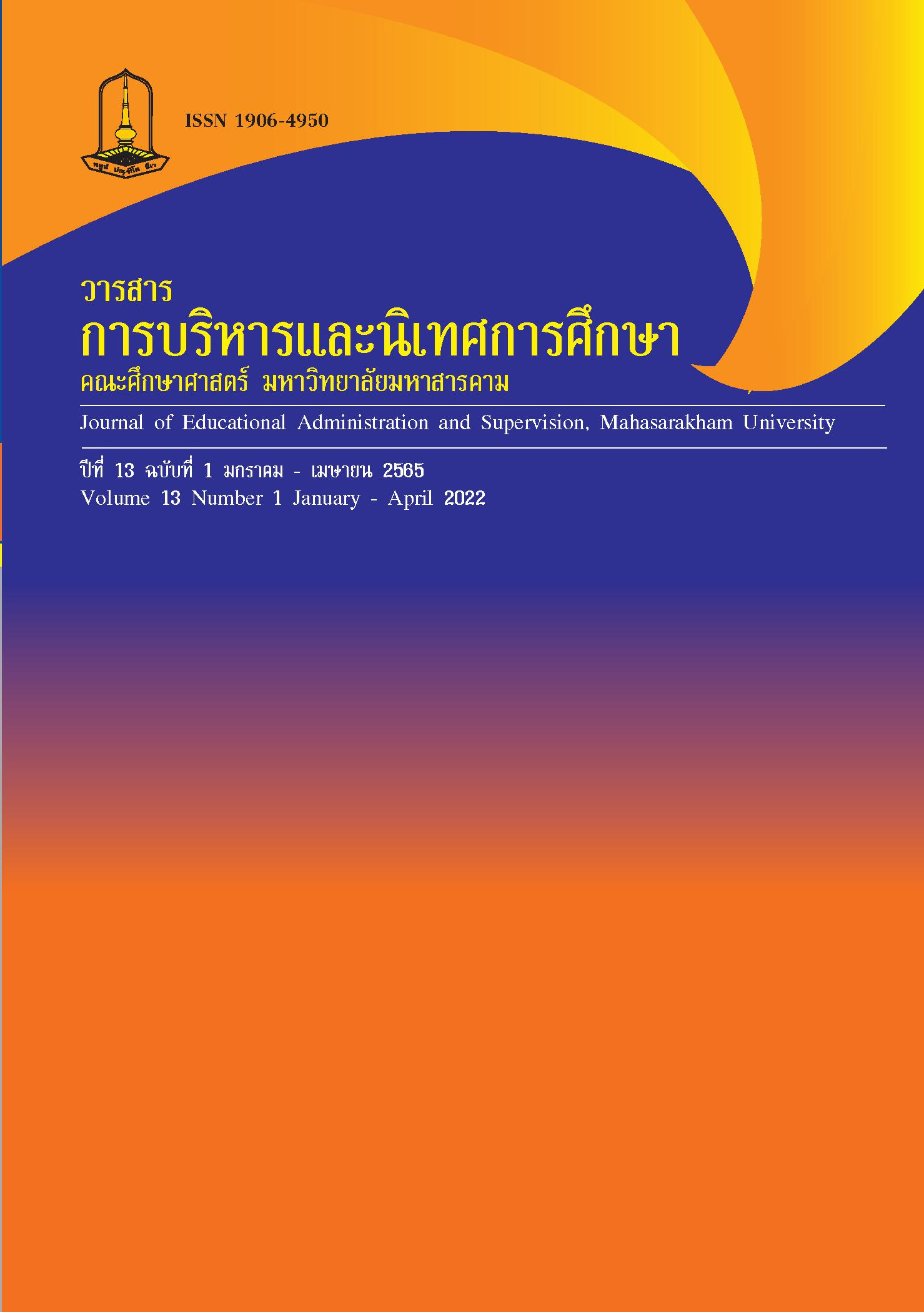Developing a teaching model based on the concept of collaborative learning theory computer course by using the website
Main Article Content
Abstract
The objectives of the research were to develop a Developing a teaching model based on the concept of collaborative learning theory computer course by using the website. The sample subjects of the study were forty 9th grade students of class 1 at Tassaban
2 Esantheerawittayakan School in the second semester of 2018. The research instrument was a web-based collaborative learning model, twelve lesson plans, forty items of an achievement test, and a questionnaire. The statistics used were the percentage, mean,
and standard deviation. Results of the research were as follows:
1. The study showed that the Develop a teaching model based on the concept ofcollaborative learning theory. computer course by using the website subject consisted offour parts: 1) principles, 2) objectives, 3) an instructional process, and 4) evaluation. The
instructional process consisted of three steps: 1) preparation, 2) learning exchange withpreparation, knowledge and practice, group activities, and knowledge assessment, and3) application.
2. The effects of the Develop a teaching model based on the concept of collaborative learning theory computer course by using the website were as follows.
2.1 The average efficiency of the collaborative learning model regarding thestandardized criteria was 83.27/82.92.
2.2 The average effectiveness of the web-based collaborative learning model in learning was 0.4131.
2.3 The average score of the students after using the web-based collaborative learning model was significantly higher than that of before using the model at the.05 level.
2.4 The overall satisfaction of the students with the web-based collaborative learning model was at the highest level ( =4.66, S.D.=0.48)
Downloads
Article Details
References
กระทรวงศึกษาธิการ. (2545). หลักสูตรการศึกษาขั้นพื้นฐานพุทธศักราช 2554. พิมพ์ครั้งที่ 3. กรุงเทพฯ: โรงพิมพ์คุรุสภาลาดพร้าว.
จิระ ดีช่วย. (2554). การพัฒนารูปแบบการเรียนการสอนตามทฤษฎีคอนสตรักติวิซึมร่วมกับการคิดอย่างมีวิจารณญาณเพื่อเสริมสร้างมโนทัศน์ทางชีววิทยาและความสามารถในการสร้างองค์ความรู้ของนักเรียนชั้นมัธยมศึกษาปีที่ 4. วิทยานิพนธ์ ปร.ด. นครปฐม: มหาวิทยาลัยศิลปกร.
ทิศนา แขมมณี. (2552). รูปแบบการเรียนการสอน: ทางเลือกที่หลากหลาย. กรุงเทพฯ: แห่งจุฬาลงกรณ์มหาวิทยาลัย.
ปสาสน์ กงตาล. (2534). การเรียนแบบร่วมมือกันเรียนรู้. วารสารศึกษาศาสตร์มหาวิทยาลัย ขอนแก่น, 18(ตุลาคม 2534), 19-23.
ปิยนันท์ ปานนิ่ม. (2559). การพัฒนารูปแบบการเรียนการสอนบนเว็บแบบผสมผสานด้วยการเรียนการสอนแบบร่วมมือ. วารสารวิจัยและพัฒนาวไลยอลงกรณ์ในพระบรมราชูปถัมภ์, 11(2), (เดือนพฤษภาคม-เดือนสิงหาคม พ.ศ. 2559).
ปานทิพย์ ดอนขันไพร. (2551). การพัฒนารูปแบบการสอนคอมพิวเตอร์แบบเน้นการร่วมมือกันเรียนรู้เพื่อเพิ่มทักษะทาคอมพิวเตอร์สำหรับนักเรียนช่วงชั้นที่ 2. วิทยานิพนธ์ วท.บ. นครปฐม: มหาวิทยาลัยราชภัฏนครปฐม.
พิณสุดา สิริธรังศรี. (2552). สภาพการศึกษาไทยในอนาคต 10-20 ปี. กรุงเทพฯ: พิมพ์ดี การพิมพ์.
วิชุดา รัตนเพียร. (2548). การเรียนการสอนบนเว็บชั้นนำ. กรุงเทพฯ: จุฬาลงกรณ์มหาวิทยาลัย.
วิทยากร เชียงกูล. (2553). รายงานสภาวะการศึกษาไทย ปี 2551/2552 บทบาทการศึกษากับการพัฒนาทางเศรษฐกิจและสังคม. พิมพ์ครั้งที่ 3. กรุงเทพฯ: วี.ที.ซี. คอมมิวนิเคชั่น.
ศยามน อินสะอาด. (2553). การพัฒนารูปแบบอ็อบเจกต์เลิร์นนิ่งเพื่อเสริมสร้างการสร้างความรู้ทักษะการคิดอย่างมีวิจารณญาณและผลสัมฤทธิ์ทางการเรียนของนักศึกษาปริญญาบัณฑิตมหาวิทยาลัยเทคโนโลยีสุรนารี. วิทยานิพนธ์ ค.ด. กรุงเทพฯ: จุฬาลงกรณ์มหาวิทยาลัย.
สายันต์ โพธิ์เกตุ. (2554). การพัฒนารูปแบบการเรียนรู้แบบร่วมมือบนเว็บวิชาฟิสิกส์ที่ส่งเสริมทักษะการคิดอย่างมีวิจารณญาณของนักศึกษาวิศวกรรมศาสตร์. วารสารศึกษาศาสตร์มหาวิทยาลัยขอนแก่น, 34(1-2), 77-86.
Driver, R.H. and Bell. (1986). Students thinking and the learning of science: A constructivist view. The School Review, 67(240), 443-456.
Driscoll, M. (2002). Blended Learning: let’s get beyond the hype. E-learning, March 2015. http://elearningmag.com/ltimagazine.
Khan, K. (ed.). (1997). Web based Instruction. Englewood Cliff, New Jersey: Educational Technology publications.
Kevin, K. (2008). Introduction to Instructional Design and ADDIE Model. [Online] Accessed 30 December 2008. Available from http:// www.e-eaningguru.com.articles/art2_1.htm
Parson, R. (1997). An Investigation into Instruction available on the World Wide Web. [n.p.].
Slavin, Robert E. (1984). Team-Assisted Individual: Cooperative Learning and Individualized instruction in the Mainstreamed Classroom. Remedial and Special Education (RASE), 5(12), 33-42.
Slavin, Robert E. (1990). Cooperative learning theory, research, and practice. Boston: Allyn and Bacon Seventh-Grade Students Achievement, Attitudes, Empathy, and Transfer of Skill.


